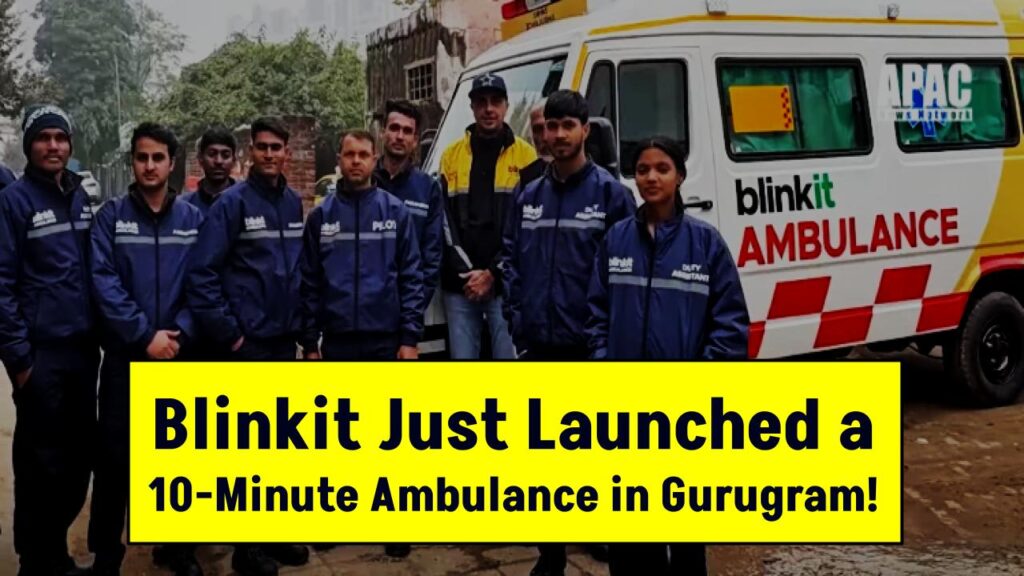Blinkit Just Launched a 10-Minute Ambulance: In a bold and potentially life-saving move, Blinkit, the popular quick-commerce brand known for delivering groceries in minutes, has officially launched a 10-minute ambulance service in Gurugram. This pioneering initiative signals a new era of tech-driven emergency healthcare in India—one where every second counts, and help could be just 10 minutes away.
Backed by Zomato, Blinkit has taken its logistics expertise beyond groceries to a much more critical domain—emergency medical response. With traffic congestion and delays often cited as major challenges in urban emergency care, this service could be a game-changer, particularly for residents of India’s rapidly growing urban hubs.

Blinkit Just Launched a 10-Minute Ambulance
| Feature | Details |
|---|---|
| Launch Location | Gurugram, Haryana |
| Response Time | Ambulance arrives in under 10 minutes |
| Booking Method | Blinkit app |
| Medical Equipment | AEDs, oxygen, stretchers, monitors, emergency meds |
| Staffing | 1 trained driver, 1 paramedic, 1 assistant |
| No. of Ambulances (Initial) | 5 ambulances in Gurugram |
| Cost Focus | Affordable; profit not the primary goal |
| Expansion Plans | Rollout to other major cities in the next 2 years |
| Official Source | Blinkit on LinkedIn |
Blinkit’s 10-minute ambulance service in Gurugram is more than a tech experiment—it’s a glimpse into the future of Indian healthcare. As private companies begin stepping up to fill critical public service gaps, this initiative could redefine how emergency care is delivered across the country.
By focusing on speed, affordability, and trained care, Blinkit is trying to prove that fast commerce logistics can save lives—not just time.
What Is Blinkit’s 10-Minute Ambulance Service All About?
At its core, Blinkit’s ambulance service mirrors the company’s well-known grocery delivery promise: speed, convenience, and reliability. But instead of delivering eggs and onions, they’re now delivering something far more urgent—life-saving care.
Here’s how it works:
A user needing emergency assistance can request an ambulance directly via the Blinkit app.
Within 10 minutes, a fully equipped ambulance staffed by trained professionals is dispatched to the user’s location.
Each ambulance comes with automated external defibrillators (AEDs), oxygen cylinders, stretchers, heart rate monitors, suction machines, and emergency drugs.
A paramedic and assistant work alongside a specially trained driver to ensure patients receive quality care even before reaching a hospital.
The service, which launched with five ambulances operating in Gurugram, is already earning praise from users, medical experts, and urban planners.
Why Gurugram First?
Gurugram, a fast-paced satellite city bordering New Delhi, presents a unique blend of challenges and opportunities. On one hand, it has high healthcare demand, dense traffic, and frequent medical emergencies. On the other, it also has tech-savvy users, solid infrastructure, and an openness to digital solutions.
Blinkit CEO Albinder Dhindsa explained via LinkedIn that this venture isn’t aimed at profit. “This is not a business; it’s a responsibility,” he wrote. Blinkit’s team saw the critical gaps in emergency healthcare—particularly in the minutes before a patient reaches a hospital—and decided to act. (Source)
Real-Life Reactions: From the Ground
So far, the response has been overwhelmingly positive. According to a report by The Indian Express, a Gurugram woman credited the Blinkit ambulance with saving her grandfather’s life. She shared how the ambulance arrived “within minutes,” and the onsite medical team administered oxygen and stabilized the patient before hospital transport.
Doctors too have applauded the high quality of pre-hospital care, which is often missing in India. Dr. Saurabh Jain, a Gurugram-based emergency care specialist, stated in LiveMint that the level of attention and equipment offered by Blinkit rivals what’s seen in developed countries.
“The ambulance staff weren’t just drivers—they were trained responders. That makes all the difference in trauma or cardiac cases,” Dr. Jain noted.
Could This Really Be the Future of Emergency Care?
- Let’s be honest—public ambulance services in India are often overburdened and underfunded. Response times can range from 20 to 45 minutes in metro areas. That’s often too late when someone’s having a stroke, cardiac arrest, or trauma.
- What Blinkit offers is a private-public hybrid model, where corporate infrastructure complements public healthcare without replacing it. Think of it like Uber—but for emergency care, regulated, professional, and equipped.
- The real kicker? Speed is not enough. Sustainability, affordability, and scalability will determine whether this model goes national or fades away after initial hype.
Challenges Ahead
- While the 10-minute ambulance service is inspiring, it’s not without hurdles:
- Scaling Up: Urban centers like Mumbai or Bangalore might pose logistical nightmares due to heavier traffic.
- Costs: Although the service is currently affordable, maintaining that price point may be tough without government collaboration or subsidies.
- Integration: Coordination with hospitals, blood banks, and emergency rooms will be vital for real impact.
Expert Opinions and Public Sentiment
- Blinkit’s bold move has attracted attention on platforms like LinkedIn, where users are praising the concept while urging rigorous quality control.
- According to The Economic Times, Blinkit plans to collaborate with local hospitals and training institutions to build a deeper ecosystem of emergency responders.
FAQs on Blinkit Just Launched a 10-Minute Ambulance
Q1: How do I book a 10-minute ambulance through Blinkit?
You can use the Blinkit app just like you would for groceries. An option to request emergency medical services will be available in supported regions.
Q2: Is the ambulance service available 24/7?
Yes, the service operates round-the-clock to handle emergencies at any time of day.
Q3: What kind of emergencies does it cover?
The ambulances are equipped to handle cardiac arrests, trauma injuries, breathing issues, and more. The goal is stabilization and fast transport.
Q4: Is there a cost to using this service?
Yes, there is a minimal cost, but Blinkit has clarified it is not profit-driven. Exact pricing may vary and will be displayed in the app.
Q5: Will the service expand to other cities?
Yes. Blinkit plans to roll out to multiple Indian cities over the next 1–2 years depending on demand and infrastructure readiness.





